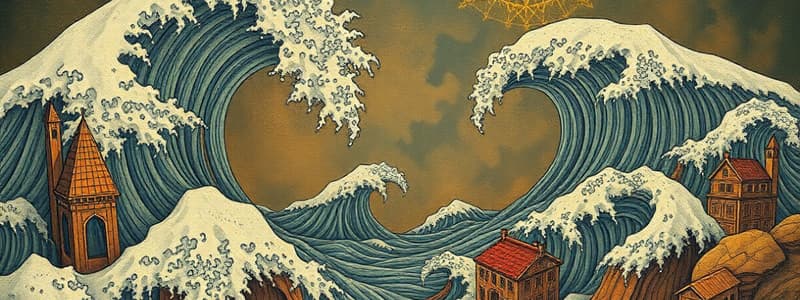Podcast
Questions and Answers
Which type of fault is most commonly associated with transform plate boundaries?
Which type of fault is most commonly associated with transform plate boundaries?
- Normal fault
- Oblique-slip fault
- Reverse fault
- Strike-slip fault (correct)
What characteristic of S-waves led scientists to conclude that Earth's outer core is liquid?
What characteristic of S-waves led scientists to conclude that Earth's outer core is liquid?
- S-waves cannot travel through liquids, creating a shadow zone. (correct)
- S-waves are absorbed by the mantle.
- S-waves change direction when entering the outer core.
- S-waves are faster than P-waves and reflect off the core.
When using triangulation to locate an earthquake's epicenter, what data is essential from at least three seismic stations?
When using triangulation to locate an earthquake's epicenter, what data is essential from at least three seismic stations?
- The intensity of the earthquake on the Modified Mercalli scale.
- The time difference between the arrival of P-waves and S-waves. (correct)
- The type of fault that caused the earthquake.
- The depth of the earthquake's focus.
Which scale is used to measure the intensity of an earthquake based on the amount of damage it causes?
Which scale is used to measure the intensity of an earthquake based on the amount of damage it causes?
Which of the following statements best describes the relationship between lava viscosity and eruption style?
Which of the following statements best describes the relationship between lava viscosity and eruption style?
An earthquake with a magnitude of 6.0 on the Richter scale releases approximately how much more energy than an earthquake with a magnitude of 5.0?
An earthquake with a magnitude of 6.0 on the Richter scale releases approximately how much more energy than an earthquake with a magnitude of 5.0?
What is the primary difference between the focus and the epicenter of an earthquake?
What is the primary difference between the focus and the epicenter of an earthquake?
A volcanologist observes an increase in the acidity of water near a volcano. What does this indicate?
A volcanologist observes an increase in the acidity of water near a volcano. What does this indicate?
How do volcanic eruptions most significantly affect global climate in the short term?
How do volcanic eruptions most significantly affect global climate in the short term?
Which of the following is NOT an indicator seismologists use to assess earthquake risk in a given area?
Which of the following is NOT an indicator seismologists use to assess earthquake risk in a given area?
Why are P-waves important in determining the structure of Earth's interior?
Why are P-waves important in determining the structure of Earth's interior?
Which type of volcano is most likely to form at a divergent plate boundary?
Which type of volcano is most likely to form at a divergent plate boundary?
What is the primary process behind the formation of volcanoes at convergent plate boundaries?
What is the primary process behind the formation of volcanoes at convergent plate boundaries?
Which of the following volcanic hazards is most likely to cause a widespread disruption to air travel?
Which of the following volcanic hazards is most likely to cause a widespread disruption to air travel?
A geologist is studying a volcano with steep sides formed from alternating layers of ash and lava. How should the geologist classify this volcano?
A geologist is studying a volcano with steep sides formed from alternating layers of ash and lava. How should the geologist classify this volcano?
What is a caldera, and under what circumstances does it form?
What is a caldera, and under what circumstances does it form?
Flashcards
Volcano
Volcano
A vent in Earth’s crust where molten rock flows out.
Volcano Formation
Volcano Formation
Where plates collide and one subducts, or where plates separate allowing magma to surface.
Shield Volcano
Shield Volcano
Large, shield-shaped with gentle slopes and eruptions.
Composite Volcano
Composite Volcano
Signup and view all the flashcards
Cinder Cone Volcano
Cinder Cone Volcano
Signup and view all the flashcards
Caldera
Caldera
Signup and view all the flashcards
Eruption Types
Eruption Types
Signup and view all the flashcards
Predicting Volcanoes
Predicting Volcanoes
Signup and view all the flashcards
Earthquake
Earthquake
Signup and view all the flashcards
Fault
Fault
Signup and view all the flashcards
Strike-Slip Fault
Strike-Slip Fault
Signup and view all the flashcards
Normal Fault
Normal Fault
Signup and view all the flashcards
Reverse Fault
Reverse Fault
Signup and view all the flashcards
Seismic Waves
Seismic Waves
Signup and view all the flashcards
Focus
Focus
Signup and view all the flashcards
Epicenter
Epicenter
Signup and view all the flashcards
Study Notes
Earthquakes
- Earthquakes involve vibrations in Earth's ground, resulting from plate movement along fault lines.
- Most earthquakes occur alongside plate boundaries.
Faults
- A fault represents a break in Earth's lithosphere where one rock block moves in relation to another.
- Strike-slip faults occur at transform plate boundaries.
- Normal faults occur at divergent plate boundaries.
- Reverse faults occur at convergent plate boundaries.
Earthquakes, Focus, and the Epicenter
- Seismic waves are energy that travels as vibrations through the earth.
- The focus is the point inside the Earth where an earthquake initiates.
- The epicenter is the location on Earth's surface directly above the focus.
Types of Seismic Waves
- Primary waves (P-waves) move in a push-pull motion and are the fastest seismic waves, capable of traveling through solids and liquids.
- Secondary waves (S-waves) are slower than P-waves, travel only through solids.
Earth's Interior
- Scientists identified that the Earth's outer core is liquid because S-waves are unable to travel through liquids, unlike P-waves.
Finding an Epicenter via Triangulation
- Calculate the time difference between the arrival of P-waves and S-waves.
- Determine the distance from the epicenter using an earthquake distance graph.
- Draw a circle with the correct distance around the station and repeat for two more stations.
- The point where the circles intersect is the epicenter.
Measuring Earthquakes
- The Richter Scale measures the amount of ground motion at a given distance.
- The Moment Magnitude Scale measures the total amount of energy released.
- The Modified Mercalli Scale measures an earthquake's intensity based on damage, using a scale from I to XII.
Earthquake Risks Assessment
- Seismologists consider past earthquakes, probability, population density, geology around a fault, and building design.
Volcanoes
- Volcanoes are vents in Earth's crust through which molten rock flows.
- Volcanoes form at:
- Convergent Boundaries: where one plate subducts under another.
- Divergent Boundaries: where plates separate such as at mid-ocean ridges and rift valleys.
- Hot Spots: not associated with plate boundaries, forming island chains like Hawaii.
Types of Volcanoes
- Shield Volcanoes: large with gentle slopes and gentle eruptions.
- Composite Volcanoes: large, steep-sided, result from explosive eruptions.
- Cinder Cone Volcanoes: small, steep-sided, erupt gas-rich, basaltic lavas, with moderately explosive eruptions.
Calderas
- Calderas are large volcanic depressions created by the collapse of a volcano's summit during a violent eruption.
Types of Eruptions
- Violent eruptions involve lava with high viscosity and gas content.
- Quiet eruptions involve lava with low viscosity and gas content.
Effects of Volcanic Eruptions
- Lava Flows: slow-moving, can destroy towns, and are rarely deadly.
- Ash Fall: can cause breathing problems, cool Earth's atmosphere, and disrupt air traffic.
- Mudflows: result from snow and ice melting and mixing with mud/ash.
- Pyroclastic Flows: deadly, produced from violent eruptions, throwing gas, ash, and rock into the air.
Predicting Volcanoes
- Ground deformation is observed.
- There is an increase in earthquakes and volcanic gas.
- Water near the volcano can become more acidic.
Climate
- Volcanic eruptions affect climate, volcanic ash can block the sun and causes a decrease in global temperatures.
- Volcanic ash can also cause acid rain.
Studying That Suits You
Use AI to generate personalized quizzes and flashcards to suit your learning preferences.




